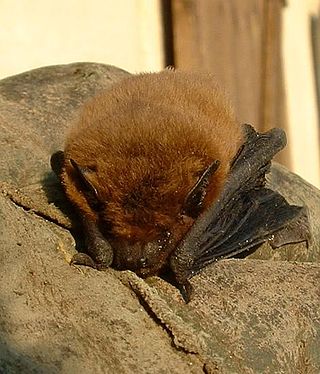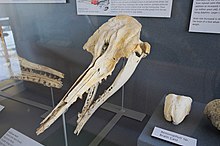Echolocation is the use of sound as a form of navigation.

Echolocation, also called bio sonar, is a biological active sonar used by several animal groups, both in the air and underwater. Echolocating animals emit calls and listen to the echoes of those calls that return from various objects near them. They use these echoes to locate and identify the objects. Echolocation is used for navigation, foraging, and hunting prey.

Microbats constitute the suborder Microchiroptera within the order Chiroptera (bats). Bats have long been differentiated into Megachiroptera (megabats) and Microchiroptera, based on their size, the use of echolocation by the Microchiroptera and other features; molecular evidence suggests a somewhat different subdivision, as the microbats have been shown to be a paraphyletic group.

Shrews are small mole-like mammals classified in the order Eulipotyphla. True shrews are not to be confused with treeshrews, otter shrews, elephant shrews, West Indies shrews, or marsupial shrews, which belong to different families or orders.

Lagenorhynchus is a genus of oceanic dolphins in the infraorder Cetacea, presently containing six extant species. However, there is consistent molecular evidence that the genus is polyphyletic and several of the species are likely to be moved to other genera. In addition, the extinct species Lagenorhynchus harmatuki is also classified in this genus.

Swiftlets are birds from the four genera Aerodramus, Collocalia, Hydrochous and Schoutedenapus, which form the tribe Collocaliini within the swift family Apodidae. The group contains around thirty species mostly confined to southern Asia, south Pacific islands, and northeastern Australia, all within the tropical and subtropical regions. They are in many respects typical members of the Apodidae, having narrow wings for fast flight, with a wide gape and small reduced beak surrounded by bristles for catching insects in flight. What distinguishes many but not all species from other swifts and indeed almost all other birds is their ability to use a simple but effective form of echolocation to navigate in total darkness through the chasms and shafts of the caves where they roost at night and breed.

Aerodramus is a genus of small, dark, cave-nesting birds in the Collocaliini tribe of the swift family. Its members are confined to tropical and subtropical regions in southern Asia, Oceania and northeastern Australia. Many of its members were formerly classified in Collocalia, but were first placed in a separate genus by American ornithologist Harry Church Oberholser in 1906.
Human echolocation is the ability of humans to detect objects in their environment by sensing echoes from those objects, by actively creating sounds: for example, by tapping their canes, lightly stomping their foot, snapping their fingers, or making clicking noises with their mouths. People trained to orient by echolocation can interpret the sound waves reflected by nearby objects, accurately identifying their location and size.

The brown long-eared bat or common long-eared bat is a small Eurasian insectivorous bat. It has distinctive ears, long and with a distinctive fold. It is extremely similar to the much rarer grey long-eared bat which was only validated as a distinct species in the 1960s. An adult brown long-eared bat has a body length of 4.5–4.8 cm, a tail of 4.1–4.6 cm, and a forearm length of 4–4.2 cm. The ears are 3.3–3.9 cm in length, and readily distinguish the long-eared bats from most other bat species. They are relatively slow flyers compared to other bat species.

Rousettus is a genus of Old World fruit bats or megabats, referred to as rousette bats. The genus is a member of the family Pteropodidae. The genus consists of seven species that range over most of Africa to southeast Asia, and the islands of the south Pacific. They are among the few megabats capable of echolocation, and the only genus of megabats known to use vocal echolocation.

The grey long-eared bat is a fairly large European bat. It has distinctive ears, long and with a distinctive fold. It hunts above woodland, often by day, and mostly for moths. In captivity, it has also been recorded to eat small lizards. It is extremely similar to the more common brown long-eared bat, and was only distinguished in the 1960s, but has a paler belly.

The south-eastern long-eared bat or Corben's long-eared bat, is a species of bat found in Australia. It occurs in the woodlands of the Murray Darling Basin and adjacent areas.

The long-eared myotis is a species of vesper bat in the suborder Microchiroptera. It can be found in western Canada, the western United States, and Baja California in Mexico.

The bicolored roundleaf bat is a species of bat in the family Hipposideridae found in Indonesia, Malaysia, Singapore, the Philippines, Thailand, and Timor-Leste. This bat inhabits caves, rock crevices and tunnels among lowland forests. They roost in large numbers and consume mostly small winged insects. Their navigation and hunting skills come from the use of echolocation. Its leafnose is used to release ultrasonic shouts to distinguish its surroundings. Echolocation is also used to distinguish other species based on their wingbeat and size. The habitat of this bat decides the color of its fur. Bleaching fumes of a cave environment will cause an orange colored fur. Those who inhabit a well-ventilated roost will be a light brown color.

Yangochiroptera, or Vespertilioniformes, is a suborder of Chiroptera that includes most of the microbat families, except the Rhinopomatidae, Rhinolophidae, Hipposideridae, and Megadermatidae. These other families, plus the megabats, are seen as part of another suborder, the Yinpterochiroptera. All bats in Yangochiroptera use laryngeal echolocation(LE), which involves the use of high-frequency sounds to detect prey and avoid obstacles.

Xenorophidae is an extinct family of odontocetes, currently known from the Oligocene of the Southeastern United States. Known genera of xenorophids include Albertocetus, Archaeodelphis, Xenorophus, Cotylocara, Echovenator, and Inermorostrum.

Echolocations: Canyon is an instrumental album by American violinist Andrew Bird and is his ninth solo studio album. It was recorded inside the Coyote Gulch canyons of Utah, and is intended as the first in a five-part Echolocations series. Echolocations: River was released October 6, 2017, and there are plans for City, Lake, and Forest installments.
Xenorophus is a genus of primitive odontocete from late Oligocene (Chattian) marine deposits in South Carolina. It belongs to the Xenorophidae.

The Malagasy yellow bat, sometimes known as the western yellow bat, is a species of vesper bat endemic to Madagascar.

The Mace Brown Museum of Natural History is a public natural history museum situated on the campus of The College of Charleston, a public liberal arts college in Charleston, South Carolina. With a collection of over 30,000 vertebrate and invertebrate fossils, the museum focuses on the paleontology of the South Carolina Lowcountry. Admission to the museum is free, and donations are welcome. The museum has the holotype specimens of Coronodon, Cotylocara, and Inermorostrum, as well as the reference specimen of Ankylorhiza tiedemani


















